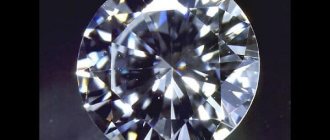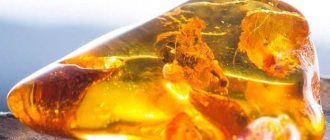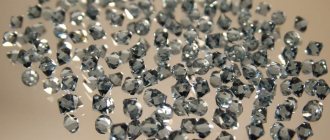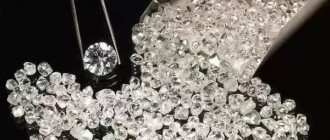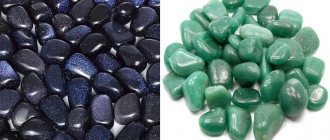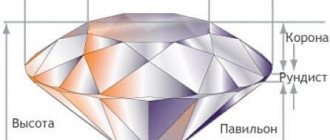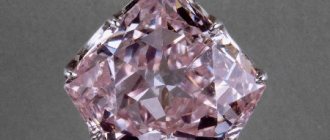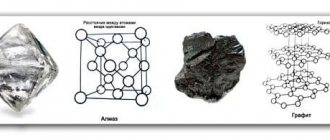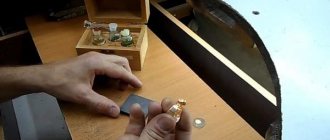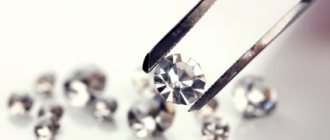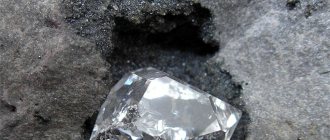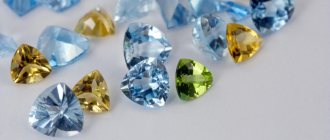When it comes to quality, diamonds are classified primarily by what is known as the 4Cs: color, clarity, cut and carat. These are the four characteristics that are considered the most important in determining how much a diamond is worth.
Besides the 4Cs, there are several other diamond features that are often included in the grading report: brilliance, symmetry, belt thickness and fluorescence, among others.
However, they do not affect the price of a diamond to the same extent as the 4Cs.
Next, we will look at the most important quality characteristics in diamond grading and take a closer look at the definitions of these characteristics.
Purity.
Diamond clarity, as its name suggests, refers to how clean the stone appears. All diamonds have some natural imperfections such as black spots, lines, surface imperfections, etc.
The smaller and less visible such imperfections are in the stone, the higher its grade of purity.
Low clarity diamonds have imperfections that are easily visible to the naked eye, while high clarity stones appear quite clean, even under magnification.
History (mythology)
Diamonds, as already mentioned, were mined in ancient times - 5 thousand years ago. It was mined in India along with rubies, sapphires, and topazes.
Among the exhibits of the British National Museum there is a figurine created by the hands of the ancient Greeks, with diamond eyes.
Indian deposits were depleted at the beginning of the 18th century. The stones were then found in Brazil, leading to the "diamond rush." Prospectors washed the sand to find precious minerals. To this day, Brazil remains a major supplier.
The first minerals were found on the territory of the Russian Federation in 1829. The Urals became a diamond mining region, then it was the turn of Yakutia, where it continues to this day.
Legends and mysteries surround this sparkling stone. Since ancient times, Indians have composed sayings about hardness, calling it “azira,” which means “indestructible.” By the way, in fact, a diamond can be destroyed by breaking a large one into small fragments.
Cut.
Diamond cut is another extremely important quality characteristic.
Generally, cut refers to the number, position and shape of a stone's facets, and the quality of the cut is related to how proportional the key parts of the diamond are relative to each other. This proportionality is usually measured by calculating a ratio based on the width, length, depth, or diameter of the diamond.
Certain cut proportions result in improved light reflection of the diamond, maximizing its brilliance. In general, the closer a diamond's measurements are to these proportions, the higher the quality of its cut is rated.
The most reliable standards in existence are those developed for the round cut, while grading scales for other cuts are not as well known.
Carat.
Carat weight is a measure of how much a diamond weighs, and 1 carat is equal to 200 milligrams.
Although carat is not a characteristic that affects a diamond's appearance in the same way as color, clarity, and cut, it is an important factor in diamond grading.
In general, larger diamonds are more expensive not only in terms of overall cost, but also in terms of price per carat. This makes sense - after all, larger diamonds are much rarer and that's why they fetch higher prices.
Description and external signs
The name of the stone comes from the ancient Greek word “adamas”, which means “indestructible”. The gem received this name for its hardness. Well, in English they call it “diamond”.
Classification (colors, varieties, types)
The varieties are as follows:
- By weight. Small - one whose weight is less than 0.29 carats. Medium - from 0.3 to 0.99 carats. If a mineral weighs more than 1 carat, then it can be classified as large.
- By scope. The following will be described in detail, but in general, the categories are as follows: technical and jewelry.
- By color. As for shades, the mineral can be transparent or “play” with different colors. The stones are milky white, gray and black, as well as slightly yellow and brown. The rarest specimens have blue, green, pink and purple shades.
Chemical composition
Allotropic form of carbon. Its chemical formula is quite simple: C. Typical impurities are N, that is, nitrogen.
Physical properties
The mineral has the following characteristics:
- Moss hardness 10 (the hardest of all minerals);
- Specific gravity - 3.417-3.55 grams per cubic centimeter;
- Density is 3.47-3.55 grams per cubic centimeter;
- The maximum birefringence is δ = 2.418, it does not have birefringence.
There is no color of the line, it has a diamond shine and is transparent. In terms of fragility - durable. The fracture of the stone is conchoidal to splintered, the system is cubic. It also has a cubic crystal lattice.
An important property is luminescence: in other words, in the rays of the sun, under X-rays or cathode rays, it begins to glow in different shades. This quality allows you to extract minerals from the depths.
Production (fields)
Despite its high cost, this is not a rare mineral; there are many places where it is mined. Interestingly, there are diamond deposits on all continents of the globe, except Antarctica. They were mined several thousand years ago.
On an industrial scale, gems are mined from kimberlite pipes. These are igneous rocks, natural sources of precious stones.
Where are the large deposits:
- India (now mostly depleted);
- Brazil (Minas Geras);
- South Africa (Kimberley, where the pipes of the same name “came” from);
- Russian Federation (Krasnoyarsk Territory and Yakutia).
Fluorescence.
Diamond fluorescence is the ability of a diamond to emit light and change color when exposed to ultraviolet rays.
For example, if you go to a nightclub and there is ultraviolet light, your diamond may start to glow blue.
Diamond reports usually include information about whether the stone shows fluorescence, as well as how strong it is.
It's worth noting that not all diamonds fluoresce, and those that can fluoresce vary in the intensity of the light they emit. Approximately one third of all diamonds that are graded show some fluorescence.
The reason for diamond fluorescence is hidden within. Diamonds contain various chemical elements that, depending on their concentration, can glow in the dark.
They can fluoresce in a variety of colors such as yellow, red and green, but the most common color is blue. Non-blue fluorescence is extremely rare.
How does fluorescence affect the quality of a diamond?
Whether a diamond is fluorescent and what color it will glow is usually listed on its grading report. The effect of fluorescence on its quality, however, is a controversial topic. The GIA (Gemological Institute of America) conducted a study on fluorescence and concluded that whether a stone is fluorescent has no effect on how the average observer perceives its quality.
It's also worth noting that the experts involved in the study couldn't agree on whether fluorescence had a significant effect on a diamond's appearance. There are jewelers who claim that in their experience, stones that show strong fluorescence also tend to appear more hazy.
Conclusion: You must decide for yourself whether a particular diamond looks good to you, regardless of fluorescence. If you think it looks a little hazy, choose another one. Don't let fluorescence alone sway your decision without looking at the stone as a whole.
Fluorescence and prices a.
Because strong fluorescence is considered a negative characteristic by some, these stones can command lower prices compared to similar graded non-fluorescent diamonds. So if you see a fluorescent diamond, check to see if it's a good buy - if you like its colour, clarity and cut, you could save some money.
Some people believe that for low color grade diamonds, those that have yellowish undertones, blue fluorescence can actually improve their appearance by masking the yellow color. Again, only you can decide whether this will be true in each case.
Stones with yellow fluorescence are typically rated lower because yellow tints are thought to reduce the quality of the diamond's color.
Stone care
If you have diamond jewelry in your home, you should appreciate it and properly care for the stones. By nature, the mineral has hardness, but during processing it decreases, and therefore a diamond can be split not only on purpose, but also accidentally - by hitting furniture or in another way. So, when wearing sparkling beauty, you need to be careful.
Twice a year you should clean your jewelry in an ultrasonic bath. This can be done in a specialized workshop. The decoration will become clean, not greasy, and will undergo antibacterial treatment.
Houses can be cleaned once every 1-1.5 months. Take a warm soapy solution, place them there for a while, then carefully wipe with a soft cloth and rinse in clean water. Household chemicals and products with a high alkali content should not be used.
Dirt can be spot removed using ammonia (immerse the product for about half an hour) and a cotton swab (pulling it out to remove stains).
Jewelry should be stored in soft velvet boxes or bags. It is best not to stack them with other products. Do not expose it to moisture by leaving it on a shelf in the bathroom.
Phosphorescence.
Once a fluorescent diamond is no longer exposed to ultraviolet light, it can continue to glow for a while. This is a rare property called phosphorescence.
When purchasing, ask to see the stone under ultraviolet and normal lighting. You should know how it will look in different conditions before you make a decision.
Be sure to look at it in daylight. Remember that sunlight contains ultraviolet rays which will bring out the fluorescent colors of your stone when it is sunny.
Stones showing yellow fluorescence will appear yellow whenever ultraviolet rays are present, including in daylight.
Keep this in mind if you want nothing to do with yellow when it comes to diamonds.
If the diamond is fluorescent, compare it to a non-fluorescent stone of similar quality to judge if you see any difference in color or clarity.
Synthetic diamonds do not fluoresce, so if a stone fluoresces, it is undoubtedly a real diamond; however, keep in mind that approximately two-thirds of real diamonds do not show fluorescence.
Famous diamonds of the world
Finally, it will be interesting to learn about the outstanding “representatives” of this category:
- Cullinan is the largest in the world, weighing about 3107 carats. Size - 100x65x50 millimeters. It was found in South Africa at the beginning of the 20th century, but then split into pieces. The original one turned into 105 small ones.
- Our light - weighing 1109 carats, was found in 2015 in Botswana. A couple of years later it fell into the hands of wealthy Briton Lawrence Graff.
- Excelsior - found in South Africa at the end of the 19th century, had a white and blue color, and later became divided into 21 separate ones.
A beautiful diamond is not for everyone; its price is such that it is not easy to get a diamond for either a collection or a jewelry box. However, those who get their hands on this brilliant gem will receive a wonderful product, a talisman and an indicator of status at the same time.
Belt.
The belt of a diamond is its edge, or the widest part of the stone (in round cuts). The classification of a belt is usually a simple description of how thick or thin it is.
It is also the line that defines the boundaries between the top and bottom areas of the diamond. The part above the girdle is called the crown, and the part below is called the pavilion.
Why is the belt so important?
The belt plays an important role when measuring the proportions of a diamond. The remaining parts of the stone are compared to the girdle in terms of size, and this comparison is used to determine how well the stone is cut.
For example, the radius of a diamond's flat top (plate), crown height, pavilion depth, and overall diamond height are often expressed as a percentage of the girdle, which is a measure of the overall width of the stone.
So why do all these percentages matter? These are very important because they determine how close the diamond's cut is to what is known as the ideal cut.
A perfectly cut diamond has optimal proportions that allow it to maximize its brilliance and sparkle when light hits it. This is why the size of all these elements relative to the band can tell you how great the diamond will look when worn.
Why is belt thickness important?
One of the most important characteristics of a diamond belt is its thickness. If it is too thin, it can easily break or chip. This can be especially problematic if you are setting the diamond in a setting, as the band may be damaged in the process.
If the girdle is too thick, the additional size of this part will come at the expense of other parts of the stone, and this is why its proportions will most likely not be optimal.
Therefore, a thick band may indicate that the brilliance and sparkle of the stone will be reduced. An uneven belt, that is, when in some parts it is thinner and in others much thicker, is also a problem. Unevenness means that the edges immediately above and below the girdle are poorly aligned and disproportionate.
In general, whenever you see any signs of poor proportions in a diamond, know that it is a poor cut that detracts from the appearance of the stone.
How is the belt classified?
GIA uses a scale with 8 grades: too thin, very thin, thin, medium, slightly thick, thick, very thick and too thick.
If the diamond is GIA graded, you will see the girdle grade on the diamond certificate.
The thickness of the belt should be somewhere between very thin and thick. The best thickness will be somewhere in the middle, ideally thin or medium.
Avoid belts that are too thin, too thick, or too thick. Remember, a disproportionate belt indicates a disproportionate cut. So if you don't know anything about the measurements of a diamond, just look at the thickness of its band.
